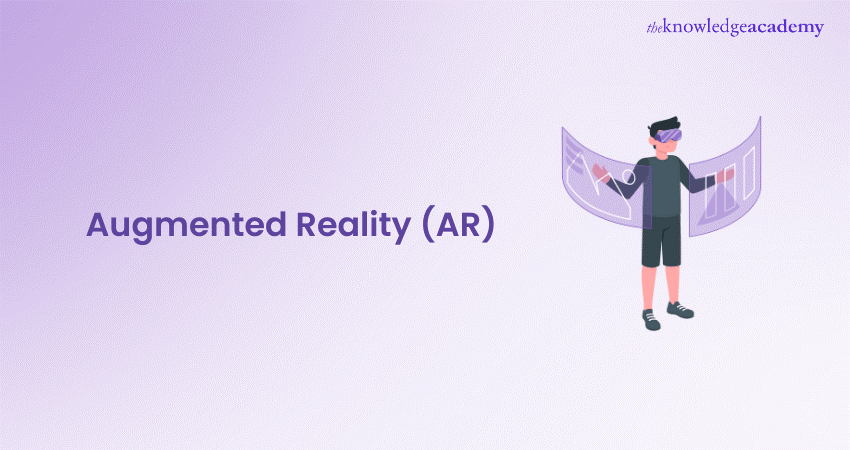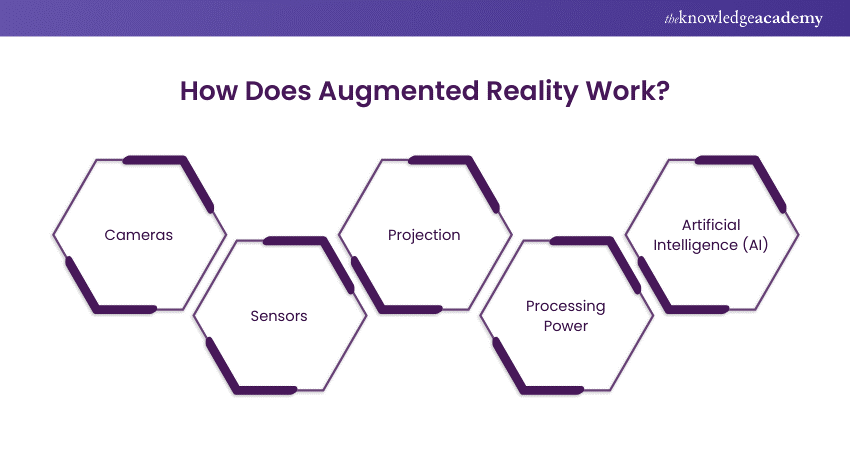We may not have the course you’re looking for. If you enquire or give us a call on +49 8000101090 and speak to our training experts, we may still be able to help with your training requirements.
Training Outcomes Within Your Budget!
We ensure quality, budget-alignment, and timely delivery by our expert instructors.

Ever wondered how technology is revolutionising our perception of the world? Enter Augmented Reality, a game-changer that’s blending the digital with the real. By using devices like smartphones and smart glasses, AR overlays digital content onto our physical surroundings, making everyday experiences more interactive and engaging.
From turning learning into an immersive adventure to transforming entertainment, AR is reshaping industries across the board. Dive into this blog to explore the fascinating world of Augmented Reality and discover how it’s adding a layer of excitement and interactivity to our daily lives!
Table of Contents
1) What is Augmented Reality?
2) How Does Augmented Reality Work?
3) What is Augmented Reality Used for?
4) Benefits of Augmented Reality
5) Differences Between AR and VR
6) Use Cases of Augmented Reality
7) Examples of Augmented Reality
8) The Future of AR Technology
9) Conclusion
What is Augmented Reality?
The word "Augment" means to increase, extend, or improve. Augmented Reality is a type of Extended Reality (XR) that enhances the real world with virtual elements, usually overlaid on a view of the real world through a visual device.
Here's a simple example: You're considering buying a new sofa for your living room. You found one online, measured your space, and thought it would fit. But you're not completely sure, and it's a big investment. AR can help. The furniture company has an app that lets you view the sofa virtually in your living room. The app uses your phone's camera and sensors to capture your room and process the data. The sofa appears in real-time on your screen, allowing you to place it and see how it looks in your space.
In short, AR helps you decide if that green velvet chesterfield is the right fit for your room. This is just one example of AR's usefulness. Keep reading to explore more industry applications.
How Does Augmented Reality Work?
Understanding how Augmented Reality works involves knowing the technology components required. Most AR programs need:

a) Cameras: AR programs use a camera to apply computer vision and understand the environment.
b) Sensors: This helps process and understand the data collected by the camera, determining object positions and other data.
c) Projection: This technology displays information visually in AR.
d) Processing Power: AR systems require processing power to function, like any computer system.
e) Artificial Intelligence (AI): AI enhances AR systems, offering features like voice command control.
What is Augmented Reality Used for?
Augmented Reality has many practical uses across different fields:
a) Retail: AR lets customers visualise products in their environment before buying, like seeing how furniture fits in their living room.
b) Gaming: It creates immersive experiences, blending the game world with the real world.
c) Education: AR provides interactive learning experiences, like 3D models of historical events or scientific concepts.
d) Healthcare: AR helps in medical training, visualising surgeries, and guiding surgeons during procedures.
e) Navigation: It enhances navigation systems by overlaying directions and information in the real world.
f) Maintenance and Repair: Technicians use AR to see detailed instructions overlaid on equipment, making repairs easier.
g) Marketing: Companies use AR for innovative marketing campaigns and product demonstrations.
These examples show the vast and growing potential of AR!
Take the next step in your AI career with our ChatGPT Prompt Engineering Certification - Register today!
Benefits of Augmented Reality
Augmented Reality offers several advantages:
a) Enhanced User Experience: AR makes experiences more immersive and engaging.
b) Increased Brand Awareness: It helps brands stand out and capture attention.
c) Improved Decision-making: AR allows users to visualise products and spaces, aiding better decisions.
d) Educational Benefits: AR provides interactive and engaging learning experiences.
e) Efficiency in Maintenance: Technicians can access detailed instructions overlaid on equipment, making repairs easier.
f) Boosted Sales: AR enhances shopping experiences, leading to higher sales.
These advantages show AR's potential to transform various industries.
Differences Between AR and VR
With Virtual Reality (VR), you can fully experience the Pokémon World. In contrast, Augmented Reality lets you see parts of the Pokémon World in the real world. That's the main difference between the two! Here is a highlighting the key differences between VR and AR.
|
Aspect |
Virtual Reality |
Augmented Reality |
|
Experience |
Fully immersive, different world |
Enhances the real world with virtual elements |
|
Requirement |
Headset necessary |
Requires only a smartphone |
|
Interaction |
Cut-off from the real world |
Maintains connection to the real world |
|
Marketing |
Harder to market (special headset required) |
Easier to market (most people have smartphones) |
|
Long-term Relevance |
Less expected due to limitations |
More expected due to accessibility and usability |
Use Cases of Augmented Reality
AR has various uses, including:
a) Retail: Consumers use store apps to see how products, like furniture, look in their homes before buying.
b) Entertainment and Gaming: AR overlays video games in the real world or animates faces on social media.
c) Navigation: Users can overlay routes to their destination on a live view of the road. It can also display information about nearby businesses.
d) Tools and Measurement: Mobile devices use AR to measure different 3D points in the environment.
e) Art and Architecture: AR helps artists visualise and work on projects.
f) Military: Data is displayed on a vehicle's windshield, showing directions, distances, weather, and road conditions.
g) Archaeology: AR helps archaeologists reconstruct sites and creates 3D models for museum visitors to experience excavations.
Do you want to enhance your Marketing Efficiency with AI tools? Sign up for our AI Tools In Performance Marketing Training today and outperform the competition!
Examples of Augmented Reality
Here are some examples of AR:
a) Target app:
The "See it in Your Space" feature lets users take a photo of their home and digitally view objects, like a picture or chair, to see how it will look.
b) Apple Measure app:
This iOS app acts as a tape measure, letting users select points in their environment and measure the distance between them.
c) Snapchat:
Users can overlay filters or masks on their videos or pictures.
d) Pokemon Go:
This mobile AR game uses GPS sensors to show Pokemon creatures in the user's surroundings so they can catch them.
e) Google Glass:
Google's first commercial glasses-based AR system, discontinued in 2023, let users work hands-free. Companies like DHL and DB Schenker used it for logistics and shipping.
f) U.S. Army Tactical Augmented Reality (TAR):
AR in an eyepiece mounted on a soldier's helmet to locate another soldier's position.
g) Apple Vision Pro:
A spatial computing device with AR, VR, and mixed-reality features. It live-maps the user's environment, offers passthrough, and allows pinning projections like web browsing windows. Users control it using gestures.
h) Meta Quest 3:
A mixed-reality headset with features similar to Apple Vision Pro, including passthrough and productivity features. Users control it through gestures or controllers.
The Future of AR Technology
AR technology is steadily growing as apps and games like Pokémon Go, and retail store AR apps become more popular. Apple continues to update its AR development toolset, ARKit. Companies like Target and Ikea use ARKit in their AR shopping apps for iPhones and iPads. Let’s discuss these advancements in detail.
ARKit Advancements
ARKit 6 enables 4K high dynamic range AR rendering and improves image and video capture. It also offers a Depth API, which helps a device's camera understand object size and shape. The scene geometry feature creates a topological map of a space.
Google's ARCore Improvements
Google's ARCore platform for building AR experiences on Android and iOS is also improving. ARCore uses a geospatial API sourcing data from Google Earth 3D models and Google Maps Street View. Its Depth API, like ARKit's, is optimised for longer-range depth sensing.
New AR, VR, and Mixed-Reality Headsets
Improved AR, VR, and mixed-reality headsets are being released. Meta's Quest 3 headset, launched in October 2023, is slimmer, lighter, and more ergonomic than Quest 2. In February 2024, Apple released Apple Vision Pro, targeting early adopters and developers at a higher price point. Meta aims for a wider audience, with Quest 3 priced at £382.48, while Vision Pro is priced at about £2,681.98. Apple is expected to release a more affordable non-Pro variant in the future.
Tools for AR Developers
Apple Vision Pro developers use the visionOS software development kit, but can also use familiar Apple tools like ARKit, SwiftUI, or RealityKit to build apps.
Potential Future Advancements for AR
Potential future advancements for AR include:
a) More powerful and lighter devices.
b) AI for face and room scanning, object detection, and text recognition.
c) Expansion of 5G networks to support cloud-based AR with higher data speeds and lower latency.
Conclusion
Augmented Reality is transforming how we interact with the world by blending digital content with the real environment. It enhances experiences in industries like gaming, retail, and education, offering immersive and interactive solutions. As AR technology advances, its accessibility and applications will continue to expand, making it a key player in the digital future.
Ready to lead with AI tools? Start your journey with our expert-guided Artificial Intelligence Tools Training now!
Frequently Asked Questions

a) Marker-based AR: Uses physical markers to trigger digital content.
b) Markerless AR: Utilises GPS, accelerometers, or other sensors.
c) Projection-based AR: Projects light onto surfaces to display digital content.

a) Real-time interaction.
b) 3D registration of objects.
c) Integration with sensory input (visual, auditory, etc.).

The Knowledge Academy takes global learning to new heights, offering over 30,000 online courses across 490+ locations in 220 countries. This expansive reach ensures accessibility and convenience for learners worldwide.
Alongside our diverse Online Course Catalogue, encompassing 19 major categories, we go the extra mile by providing a plethora of free educational Online Resources like News updates, Blogs, videos, webinars, and interview questions. Tailoring learning experiences further, professionals can maximise value with customisable Course Bundles of TKA.

The Knowledge Academy’s Knowledge Pass, a prepaid voucher, adds another layer of flexibility, allowing course bookings over a 12-month period. Join us on a journey where education knows no bounds.

The Knowledge Academy offers various Artificial Intelligence Tools Training, including AI Tools In Performance Marketing Training, ChatGPT Prompt Engineering Certification and AI Tools In Performance Marketing Training. These courses cater to different skill levels, providing comprehensive insights into the 15 Best Chatgpt Plugins You Need to Try Today.
Our Data, Analytics & AI Blogs cover a range of topics related to AI, offering valuable resources, best practices, and industry insights. Whether you are a beginner or looking to advance your skills in Data, Analytics & AI, The Knowledge Academy's diverse courses and informative blogs have you covered.
Upcoming Data, Analytics & AI Resources Batches & Dates
Date
 AI Tools in Performance Marketing Training
AI Tools in Performance Marketing Training
Fri 28th Feb 2025
Fri 4th Apr 2025
Fri 27th Jun 2025
Fri 29th Aug 2025
Fri 24th Oct 2025
Fri 5th Dec 2025







 Top Rated Course
Top Rated Course



 If you wish to make any changes to your course, please
If you wish to make any changes to your course, please


